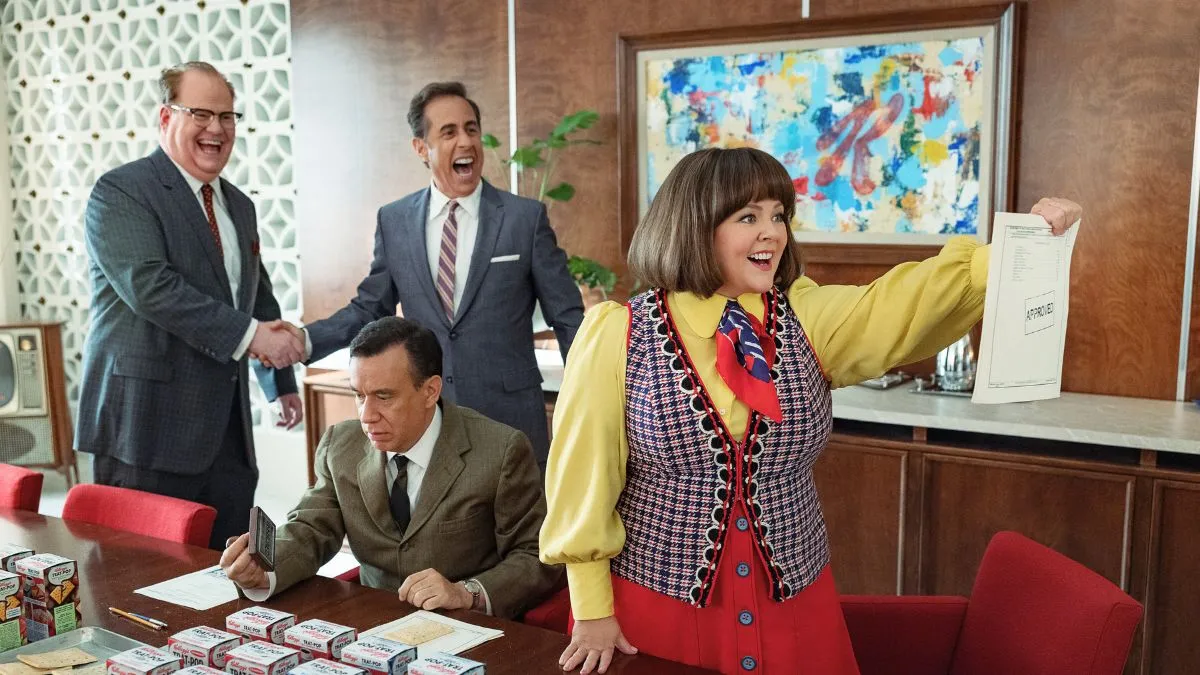The opening scene of “Unfrosted” sets the stage with Jerry Seinfeld’s character, Bob Cabana, captivating a young admirer with the intriguing tale of how the iconic breakfast pastry, the Pop-Tart, came to be. This storytelling device serves as a whimsical gateway into the fantastical world of the film, allowing the audience to suspend disbelief and embrace the whimsy that unfolds.
Throughout the film, this initial interaction with the eager youngster serves as a thematic anchor, validating the creative liberties taken by the director to cater to a child’s vivid imagination. Despite the corporate backdrop of the narrative, characterized by the cutthroat world of cereal businesses, the film ventures into realms of absurdity and over-the-top plot points that might seem incongruous at first glance. However, this departure from reality is seamlessly justified by the whimsical framing device of Bob Cabana’s storytelling, appealing to the young audience’s appetite for fantastical storytelling.
Despite its reliance on references to 1960s pop culture, which might alienate some viewers, “Unfrosted” is poised to resonate most strongly with its target demographic – the youthful audience captivated by tales of adventure and whimsy. The film’s blend of historical satire, irreverent humor, and infectious energy promises to entertain and delight, even if its humor occasionally requires prior knowledge of cultural references from decades past.
How does ‘Unfrosted’ end?
“Unfrosted” concludes with a nostalgic return to the diner where Bob Cabana initially shared the captivating tale of the Pop-Tart with a young admirer. This bookend ending brings the narrative full circle, as Cabana reassumes his role as the storyteller, recounting the fates of the colorful characters encountered throughout the film to the attentive listener and, by extension, the audience.
As Cabana spins his yarn, he divulges the post-script of the Pop-Tart’s success, noting its meteoric rise to fame with a whimsical touch. The breakfast pastry becomes an instant hit, flying off the shelves in a mere 60 seconds (though in reality, it sold out in two weeks). Meanwhile, the eccentric cast of characters each embarks on their own unique journeys – from Hugh Grant’s cereal mascot Thurl Ravenscroft facing legal troubles for inciting a riot, to Amy Schumer’s Marjorie Post achieving feminist icon status and constructing Mar-a-Lago.
The film doesn’t shy away from injecting humor into its conclusion, with playful jabs at historical events like the milk mafia allegedly orchestrating JFK’s assassination, and the UNIVAC computer morphing into a character reminiscent of Willard from “Apocalypse Now.”
Before returning to the diner, “Unfrosted” squeezes in one last comedic gag, revealing the origin of the Pop-Tart’s name. In a nod to reality, the pastry was named after the pop art movement led by Andy Warhol, but in the film’s universe, famed news anchor Walter Cronkite inadvertently coins the term “Pop-Tart.” This amusing twist culminates in a hilarious showdown on “The Tonight Show Starring Johnny Carson,” where Cabana, portrayed by Seinfeld, faces off against Dan Levy’s outraged portrayal of Warhol.
With the tale of the Pop-Tart and its colorful cast now complete, “Unfrosted” concludes on a high note with an old-school dance number featuring the entire ensemble, set to the infectious beat of Meghan Trainor’s “Sweet Morning Heat.” This celebratory finale encapsulates the film’s playful spirit and leaves the audience with a sense of joy and nostalgia.

